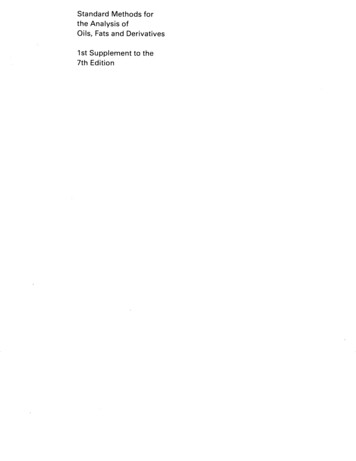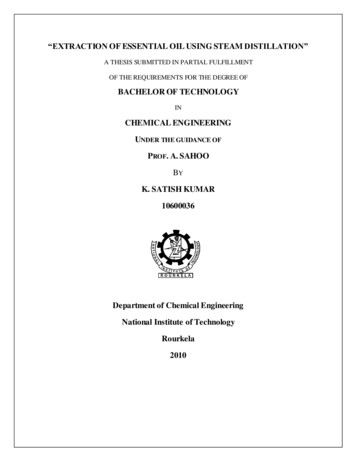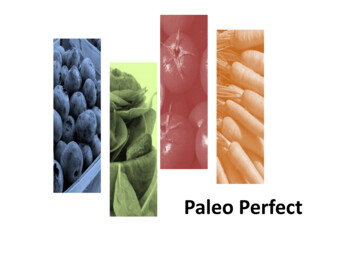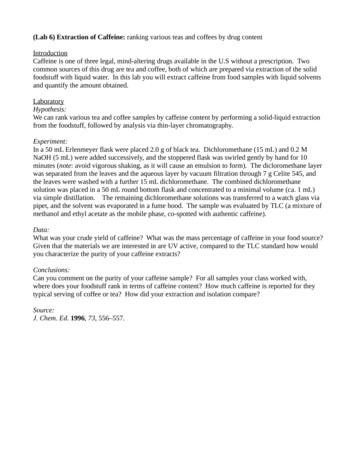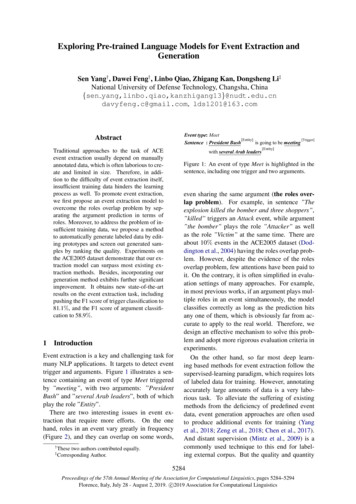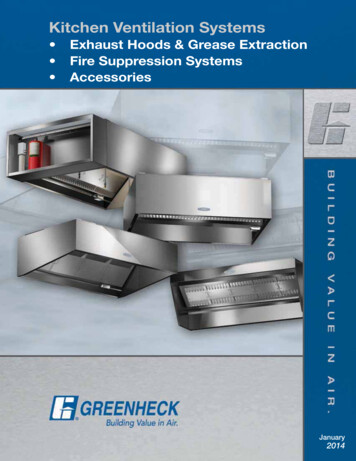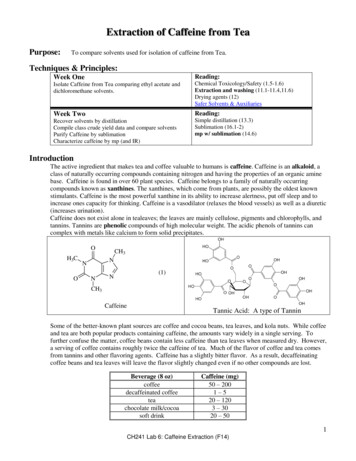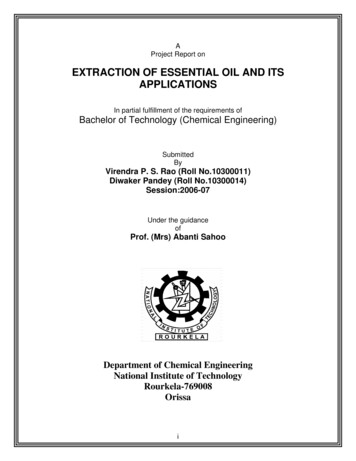
Transcription
AProject Report onEXTRACTION OF ESSENTIAL OIL AND ITSAPPLICATIONSIn partial fulfillment of the requirements ofBachelor of Technology (Chemical Engineering)SubmittedByVirendra P. S. Rao (Roll No.10300011)Diwaker Pandey (Roll No.10300014)Session:2006-07Under the guidanceofProf. (Mrs) Abanti SahooDepartment of Chemical EngineeringNational Institute of TechnologyRourkela-769008Orissai
National Institute of TechnologyRourkelaCERTIFICATEThis is to certify that that the work in this thesis report entitled “Extraction of EssentialOil and its applications” submitted by Virendra P.S.Rao and Diwaker Pandey in partialfulfillment of the requirements for the degree of Bachelor of Technology in ChemicalEngineering Session 2003-2007 in the department of Chemical Engineering, NationalInstitute of Technology Rourkela, Rourkela is an authentic work carried out by themunder my supervision and guidance.To the best of my knowledge, the matter embodied in the thesis has not been submitted toany other University/Institute for the award of any degree.Date:Prof. (Mrs.) Abanti SahooAsst.ProfessorDepartment of Chemical EngineeringNational Institute of TechnologyRourkela - 769008ii
ACKNOWLEDGEMENTWe express sincere gratitude to our project guide Prof. (Mrs) Abanti Sahoo, Asstprofessor for her kind support , guidance and constructive criticism in thecompletion of project. We are thankful to Mr. R.K. Singh for his sincerity overthe project.We are also thankful to Prof. Pradip Rath, Head of the Department, for providingus the necessary opportunities for the completion of our project.Virendra P.S.Rao (Roll No. 10300011)Diwaker Pandey (Roll No. 10300014)B.Tech. Final Yr. Chem. Engg.iii
CONTENTTitlePage NoFigures and TablesvAbstractviChapter 1INTRODUCTION1-3Chapter 2LITERATURE SURVEY4-232.1 What are Essential Oil?52.2 What is Aromatherapy?82.3 Pharmacological Properties of Essential Oil.92.4 Chemical Constituents of Essential Oil.102.5 Methods of Extracting Essential Oil.152.6 Extraction of Essential Oil by usingSteam Distillation method2.7 Application of oil Extracted from Eucalyptus18Chapter 3EXPERIMENTAL WORK2124-313.1 Experimental Set-up253.2 Experimental Procedure273.3 Experimental Observations283.4 Analysis of Essential Oil( Study )29RESULTS AND DISCUSSIONChapter 44.1 InferencesChapter 532-343335CONCLUSIONREFERENCES37-39iv
Figure ContentsTitlePage No.Figure-3.1: Flow diagram for the Steam Distillation25Figure-3.2: Essential Oil Steam Distiller26Figure-3.3: Flow Diagram for Steam distillation27Figure-3.4: Chromatographic Analysis of Eucalyptus Oil30Figure-3.5: Experimental Setup of Gas Chromatography31Figure-4.1 : Eucalyptus Oil obtained Vs Time33Figure-4.2: Eucalyptus Oil obtained Vs Temperature of the water34Table ContentTable-1.1: Major raw materials used for the extraction of Essential oil07Table-3.1: Physical and Chemical Properties of Eucalyptus oil28Table-3.2: Chromatographic data of Eucalyptus Oil30v
ABSTRACTEssential oils are highly concentrated substances extracted from flowers, leaves, stems,roots, seeds, barks, resins, or fruit rinds. These oils are often used for their flavor andtheir therapeutic or odoriferous properties, in a wide selection of products such as foods,medicines, and cosmetics. Extraction of essential oils is one of the most time- and effortconsuming processes. The way in which oils are extracted from plants is importantbecause some processes use solvents that can destroy the therapeutic properties. Thereare wide number of ways to extract the Essential oil but the quality never remains thesame. Here we are using the “Steam Distillation” method for extraction which is thecheapest way for the extraction of Oils from the different parts of the plants. In thisprocess steam is allowed to pass through the extraction chamber which contains plantmatter. When steam passes through the herb material under pressure which softens thecells and allows the essential oil to escape in vapor form. The vapour allows to passthrough condenser and oil is collected in separating funnel and separated. Compositiondata for Eucalyptus oil were studied and found the Eucalyptus oil can be used ascosolvent which results in depression of cloud point temperature.vi
CHAPTER-1INTRODUCTION1
Humankind has used plants for healing for many thousands of years, and it's from thistradition of that the use of aromatic plant compounds is medicine began. Oils were usedin the embalming process, in medicine and in purification rituals. There are also over 200references to aromatics, incense and ointments in the Old and New Testaments;Frankincense, Myrrh, Galbanum, Cinnamon, Cassia, Rosemary, Hyssop and Spikenardare noted for being used for anointing rituals and healing of the sick.Research has confirmed centuries of practical use of essential oils, and we now know thatthe 'fragrant pharmacy' contains compounds with an extremely broad range ofbiochemical effects. There are about three hundred essential oils in general use today byprofessional practitioners. With the continual bombardment of viral, bacterial, parasiticand fungal contamination in our world, essential oils are a great benefit to help protectour bodies and homes from this onslaught of pathogens. Immune system systems needsupport and essential oils can give it.Because of the enormous amount of raw product used to make wholly natural essentialoils, lots of products on the market have been polluted with lower quality, commercial –grade oils or contain other chemical substances to reduce the cost or increase the profitmargin – a fact not usually revealed on the label. This is why it is important to study thechemical composition of the volatile fraction once the essential oil is extracted. Thisfraction is characterized by the complexity in the separation of its components, whichbelong to various classes of compounds and which are present in a wide range ofconcentrations. Therefore it is complicated to establish a composition profile of essentialoils. The gas chromatographic method (GC) is almost exclusively used for the qualitativeanalysis of volatiles. The analysis of essential oils was developed in parallel with thetechnological developments in GC, such as stationary phases, detection devices, etc.However, advances in instrumentation were not the only important factor in thedevelopment of analytical methods for essential oils in plants. Sample extraction andconcentration were also improved. The most outstanding improvements in thedetermination of the composition of essential oils came from the introduction of tandem2
techniques involving prior/further chromatography or spectroscopy. The great amount ofinformation on the application of GC and hyphenated techniques to essential oils has ledto much research in this field.3
CHAPTER-2LITERATURE SURVEY4
2.1. What are Essential Oils?Essential oils are concentrated volatile aromatic compounds produced by plants the easily evaporated essences that give plants their wonderful scents. Each of thesecomplex precious liquids is extracted from a particular species of plant life. Each plantspecies originates in certain regions of the world, with particular environmentalconditions and neighboring fauna and flora.Essential oils are frequently referred to as the “life force” of plants. Unlike fatty oils,these "essential" oils are volatile, highly concentrated, substances extracted from flowers,leaves, stems, roots, seeds, bark, resin or fruit rinds. The amount of essential oils found inthese plants can be anywhere from 0.01 percent to 10 percent of the total. That's why tonsof plant material are required for just a few hundred pounds of oil. These oils have potentantimicrobial factors, having wide range of therapeutic constituents. These oils are oftenused for their flavor and their therapeutic or odoriferous properties, in a wide selection ofproducts such as foods, medicines, and cosmetics. Beware of imitations. Essential oilscannot be substituted with synthetics. Only pure oils contain a full spectrum ofcompounds that cheap imitations simply cannot duplicate.What do the Essential Oils do for the Plants?Essential oils are extracted from oil 'sacs' in flowers, leaves, stems, roots, seeds,wood and bark. They differ significantly from the well-known vegetable, nut and seedoils which are made up of various fatty acids (essential oils are not). Essential oils areused by the plants in somewhat the same way they are by humans - they fight infection,contain hormone-like compounds, initiate cellular regeneration, and work as chemicaldefense against fungal, viral, and animal foes. Despite their foliar origins however,essential oils have a similar structure to some compounds found in blood and tissues,allowing them to be compatible with our own physiology.5
How to Use Essential Oils?The most effective way to use most essential oils is by external application orinhalation, though some can be very beneficial when taken internally. The use ofessential oils include body oils, compresses, cosmetic lotions, baths, hair rinses,inhalation by steam, perfumes and room sprays. Essential oils are very potent - somewill cause skin irritation or have other harmful effects if not used properly. Unlessspecifically noted, it is best to dilute all essential oils in a carrier of base oil like Almond,Jojoba or Apricot Kernel before applying to the skin - appropriate dilution is usually only1 - 10% essential oil in carrier. For inhalation, a diffuser or oil lamp is effective forreleasing essential oils into your environment - a very pleasant way of creating aparticular atmosphere.6
Table-1.1Major Raw Material Used In Extraction Of Essential Oils:Essential Oils are derived from various parts of gamotAlmondCamphorBay leafClary SageGrape alyptusGeraniumLimeCuminSandalwoodLemon GrassHyssopOrangeNutmeg earmintYlang-YlangTea tValerian
2.2. What is Aromatherapy?“Thetreatment of anxiety or minor medical conditions by rubbing pleasantsmelling natural oils into the skin or breathing in their smell. ”It is the use of aromatic essential oils to benefit the body – in emotional andphysical health and beauty. Science has discovered that our sense of smell plays asignificant role in our overall health.Many common essential oils have medicinal properties that have been applied inmedicine since ancient times and are still widely used today. For example, many essentialoils have antiseptic properties, though some are stronger than the other. In addition, manyhave an uplifting effect on the mind, though different essential oils have differentproperties.The Beginnings of Modern AromatherapyThe first modern-day distillation of essential oil was performed by the Persianphilosopher Avicenna (980-1037 A.D.) who extracted the essence of rose petals throughthe 'enfleurage' process. His discovery and subsequent use of a wonderful perfumesubstance eventually lead him to write a book on the healing properties of essential oil ofRose.Early in the 20th century a French Chemist, Rene-Maurice Gattefosse, beganstudying what he called “ Aromatherapy .“ After several burning his arm in a laboratoryaccident, he thrust the arm into the nearest liquid, which happened to be tub of LavenderOil. Surprised by the quick healing that followed, Dr. Gattefosse spent the remainder ofhis life researching the value of Essential Oils. His success made aromatherapy popular,and it became well-known in Europe.How Essential Oil Works in Aromatherapy?An Essential Oil is inhaled and directly by the olfactory system to the limbicSystem of the Brain. In true, the brain responds to the particular scent affecting ouremotions and chemical balance. Essential Oils also absorbed by the skin and carriedthroughout the body via the circulatory system to reach all internal organs.8
By carefully choosing one or more oils, you can experience benefical effectspromoting overall health - and even specific targets. Benefits depend upon the uniquenature of each person’s response to an aromatic stimulus.2.3. Pharmacological Properties of Essential Oils Antiseptics:Essential oils have antiseptic properties and are active against a wide range ofbacteria as well as on antibio-resistant strains. Moreover, they are also known to be activeagainst fungi and yeasts (Candida).The most common sources of essential oils used asantiseptics are: Cinnamon, Thyme; Clover; Eucalyptus; Culin savory; Lavender. Citral,geraniol, linalool and thymol are much more potent than phenol. Expectorants and diuretics:When used externally, essential oils like (L’essence de terebenthine) increasemicrocirculation and provide a slight local anaesthetic action. Till now, essential oils areused in a number of ointments, cream and gels, whereby they are known to be veryeffective in relieving sprains and other articular pains. Oral administration of essentialoils like eucalyptus or pin oils, stimulate ciliated epithelial cells to secrete mucus. On therenal system, these are known to increase vasodilation and in consequence bring about adiuretic effect. Spasmolytic and sedative:Essential oils from the Umbellifereae family, Mentha species and verbena are reputedto decrease or eliminate gastrointestinal spasms. These essential oils increase secretion ofgastric juices. In other cases, they are known to be effective against insomnia. Others:Cholagogue; anti-inflammatory; cicatrizing9
2.4. Chemical Constituents of Essential OilsPure essential oils are mixtures of more than 200 components, normally mixtures ofterpenes or phenylpropanic derivatives, in which the chemical and structural differencesbetween compounds are minimal. They can be essentially classified into two groups: Volatile fraction: Essential oil constituting of 90–95% of the oil in weight,containing the monoterpene and sesquiterpene hydrocarbons, as well as their oxygenatedderivatives along with aliphatic aldehydes, alcohols, and esters. Nonvolatile residue: that comprises 1–10% of the oil, containing hydrocarbons,fatty acids, sterols, carotenoids, waxes, and flavonoids.2.4.1. Hydrocarbon:Essential Oils consist of Chemical Compounds that have hydrogen and carbon as theirbuilding blocks. Basic Hydrocarbon found in plants are isoprene having the followingstructure.(Isoprene)2.4.2. Terpenes:Generally have names ending in “ ene.”For examples: Limonene, Pinene, Piperene, Camphene, etc. Terpenes are antiinflammatory, antiseptic, antiviral, and bactericidal. Terpenes can be further categorizedin monoterpenes, sesquiterpenes and diterpenes. Referring back to isoprene units underthe Hydrocarbon heading, when two of these isopreneunits join head to tail, the result is a monoterpene, when three join, it’s a sesquiterpeneand four linked isoprene units are diterpenes.10
2.4.2.a. Monoterpenes [C10H16 ]Properties: Analgesic, Bactericidal, Expectorant, and Stimulant.Monoterpenes are naturally occurring compounds, the majority being unsaturatedhydrocarbons (C10 ).But some of their oxygenated derivatives such as alcohols, Ketones,and carboxylic acids known as monoterpenoids.(Limonene)(Menthol)The branched-chain C10 hydrocarbons comprises of two isoprene units and is widelydistributed in nature with more than 400 naturally occurring monoterpenes identified.Moreover, besides being linear derivatives (Geraniol, Citronellol), the monoterpenes canbe cyclic molecules (Menthol – Monocyclic; Camphor – bicyclic; Pinenes (α and β) –Pine genera as well. Thujone (a monoterpene) is the toxic agent found in Artemisiaabsinthium (wormwood) from which the liqueur, absinthe, is made. Borneol and camphorare two common monoterpenes. Borneol, derived from pine oil, is used as a disinfectantand deodorant. Camphor is used as a counterirritant, anesthetic, expectorant, andantipruritic, among many other uses.Example:¾ Camphene and pinene in cypress oil.¾ Camphene, pinene and thujhene in black pepper.2.4.2. b. SesquiterpenesProperties: anti-inflammatory, anti-septic, analgesic, anti-allergic.Sesquiterpenes are biogenetically derived from farensyl pyrophosphate and in structuremay be linear, monocyclic or bicyclic. They constitute a very large group of secondarymetabolites, some having been shown to be stress compounds formed as a result ofdisease or injury.11
Sesquiterpene Lactones:Over 500 compounds of this group are known; they are particularly characteristics ofthe Compositae but do occur sporadically in other families. Not only have they proved tobe of interest from chemical and chemotaxonomic viewpoints, but also possess manyantitumor, anti-leukemia, cytotoxic and antimicrobial activities. They can be responsiblefor skin allergies in humans and they can also act as insect feeding deterrents.Chemically the compounds can be classified according to their carboxylic skeletons; thus,from the germacranolides can be derived the guaianolides, pseudoguaianolides,eudesmanolides, eremophilanolides, xanthanolides, etc.A structural feature of all these compounds, which appears to be associated withmuch of the biological activity, is the α, β -unsaturated- γ- lactones.Example:¾ Farnesene in chamomile and lavender.¾ Beta-caryophyllene in basil and black pepper.2.4.2.c. DiterpenesProperties: anti-fungal, expectorant, hormonal balancers, hypotensiveDiterpenes are made of up four isoprene units. This molecule is too heavy to allow forevaporation with steam in the distillation process, so is rarely found in distilled essentialoils. Diterpenes occur in all plant families and consist of compounds having a C2012
skeleton. There are about 2500 known diterpenes that belong to 20 major structural types.Plant hormones Gibberellins and phytol occurring as a side chain on chlorophyll arediterpenic derivatives. The biosynthesis occurs in plastids and interestingly mixtures ofmonoterpenes and diterpenes are the major constituents of plant resins. In a similarmanner to monoterpenes, diterpenes arise from metabolism of geranyl geranylpyrophosphate (GGPP).Diterpenes have limited therapeutical importance and are used in certain sedatives(coughs) as well as in antispasmodics and antoxiolytics.Example:¾ Sclareol in clary sage is an example of a diterpene alcohol.2.4.3. AlcoholsProperties: anti-septic, anti-viral, bactericidal and germicidal.Alcohols are the compounds which contains Hydroxyl compounds. Alcohols existnaturally, either as a free compound, or combined with a terpenes or ester. When terpenesare attached to an oxygen atom, and hydrogen atom, the result is an alcohol. When theterpene is monoterpene, the resulting alcohol is called a monoterpenol. Alcohols have avery low or totally absent toxic reaction in the body or on the skin. Therefore, they areconsidered safe to use.Example:¾ linalool found in ylang-ylang and lavender.¾ Geraniol in geranium and rose.¾ Nerol in neroli.2.4.4. ,anti-septic,anti-viral,bactericidal,disinfectant, sedative.Medicinally, essential oils containing aldehydes are effective in treating Candida andother fungal infections.Example:¾ Citral in lemon.13
¾ Lemongrass and lemon balm.¾ Citronellal in lemongrass, lemon balm and citrus eucalyptus.2.4.5. AcidsProperties: anti-inflammatory.Organic acids in their free state are generally found in very small quantities withinEssential oils. Plant acids act as components or buffer systems to control acidity.Example:¾ Cinnamic and benzoic acid in benzoin.¾ Citric and lactic.2.4.6. EstersEsters are formed through the reaction of alcohols with acids. Essential oils containingesters are used for their soothing, balancing effects. Because of the presence of alcohol,they are effective antimicrobial agents. Medicinally, esters are characterized as antifungaland sedative, with a balancing action on the nervous system. They generally are free fromprecautions with the exception of methyl salicylate found in birch and wintergreen whichis toxic within the system.Example:¾ linlyl acetate in bergamot and lavender.¾ Geranyl formate in geranium.2.4.7. Ketones:Properties: anti-catarrhal, cell proliferant, expectorant, vulnery.Ketones often are found in plants that are used for upper respiratory complaints. Theyassist the flow of mucus and ease congestion. Essential oils containing ketones arebeneficial for promoting wound healing and encouraging the formation of scar tissue.Ketones are usually (not always) very toxic. The most toxic ketone is Thujone found inmugwort, sage, tansy, thuja and wormwood oils. Other toxic ketones found in essential14
oils are pulegone in pennyroyal, and pinocamphone in hyssops. Some non-toxic ketonesare jasmone in jasmine oil, fenchone in fennel oil, carvone in spearmint and dill oil andmenthone in peppermint oil.Example:¾ fenchone in fennel, carvone in spearmint and dill¾ Menthone in peppermint.2.4.8. LactonesProperties: anti-inflammatory, antiphlogistic, expectorant, febrifuge.Lactones are known to be particularly effective for their anti-inflammatory action,possibly by their role in the reduction of prostaglandin synthesis and expectorant actions.Lactones have an even stronger expectorant action then ketones.2.5. Methods of Extracting Essential OilsEarly efforts at extraction used alcohol and a fermentation process. New methods ofessential oils extraction are entering the mainstream of aromatherapy, offering newchoices in oils never before available. With the new labels of CO2 and Super CriticalCO2, along with the traditional ‘steam’ and ‘hydro’ distillations, 'absolutes', and 'coldpressing', a little education for the aromatherapy enthusiast can go a long way in essentialoil selection. Is one process better than another? Does one produce nicer smelling oil, orone with greater aroma therapeutic value? It turns out that essential oil production, likewinemaking, is an art form as well as a science. The way in which oils are extracted fromplants is important because some processes use solvents that can destroy the therapeuticproperties. Some plants, and particularly flowers, do not lend themselves to steamdistilling. They are too delicate, or their fragrance and therapeutic essences cannot becompletely released by water alone. These oils will be produced as 'absolutes' – and whilenot technically considered essential oils they can still be of therapeutic value. Jasmine oiland Rose oil in particular are delicate flowers whose oils are often found in 'absolute'form.15
The value of the newer processing methods depends greatly on the experience of thedistiller, as well as the intended application of the final product. Each method isimportant, and has its place in the making of aromatherapy-grade essential oils. Some ofthe few methods are available for extractions of essential oils are given below:2.5.1. Maceration: Maceration actually creates more of an”infused oil" rather than an"essential oil". The plant matter is soaked in vegetable oil, heated and strained at whichpoint it can be used for massage.2.5.2. Cold Pressing: Cold pressing is used to extract the essential oils from citrusrinds such as orange, lemon, grapefruit and bergamot. This method involves the simplepressing of the rind at about 120 degrees F to extract the oil. The rinds are separated fromthe fruit, are ground or chopped and are then pressed. The result is a watery mixture ofessential oil and liquid which will separate given time. Little, if any, alteration from theoil's original state occurs – these citrus oils retain their bright, fresh, uplifting aromas likethat of smelling a wonderfully ripe fruit. It is important to note that oils extracted usingthis method have a relatively short shelf life, so make or purchase only what you will beusing within the next six months.2.5.3. Solvent Extraction: A hydrocarbon solvent is added to the plant material tohelp dissolve the essential oil. When the solution is filtered and concentrated bydistillation, a substance containing resin (resinoid), or a combination of wax and essentialoil (known as concrete) remains. From the concentrate, pure alcohol is used to extract theoil. When the alcohol evaporates, the oil is left behind. This is not considered the bestmethod for extraction as the solvents can leave a small amount of residue behind whichcould cause allergies and effect the immune system.2.5.4. Enfleurage: An intensive and traditional way of extracting oil from flowers.The process involves layering fat over the flower petals. After the fat has absorbed the16
essential oils, alcohol is used to separate and extract the oils from the fat. The alcohol isthen evaporated and the essential oil collected.2.5.5. Hydro distillation: Some process becomes obsolete to carry out extractionprocess like Hydro Distillation which often used in primitive countries. The risk is thatthe still can run dry, or be overheated, burning the aromatics and resulting in an EssentialOil with a burnt smell. Hydro distillation seems to work best for powders (i.e., spicepowders, ground wood, etc.) and very tough materials like roots, wood, or nuts.2.5.6. CO2 & Super Critical CO2 Extraction: The most modern technologies,Carbon Dioxide and Supercritical Carbon Dioxide extraction involve the use of carbondioxide as the 'solvent' which carries the essential oil away from the raw plant material.The lower pressure CO2 extraction involves chilling carbon dioxide to between 35 and 55degrees F, and pumping it through the plant material at about 1000 psi. The carbondioxide in this condition is condensed to a liquid. Supercritical CO2 extraction (SCO2)involves carbon dioxide heated to 87 degrees F and pumped through the plant material ataround 8,000 psi – under these conditions; the carbon dioxide is likened to a 'dense fog'or vapor. With release of the pressure in either process, the carbon dioxide escapes in itsgaseous form, leaving the essential oil behind. The usual method of extraction is throughsteam distillation. After extraction, the properties of a good quality essential oil shouldbe as close as possible to the "essence" of the original plant. The key to a 'good' essentialoil is through low pressure and low temperature processing. High temperatures, rapidprocessing and the use of solvents alter the molecular structure, will destroy thetherapeutic value and alter the fragrance.2.5.7. Turbo Distillation Extraction: Turbo distillation is suitable for hard-toextract or coarse plant material, such as bark, roots, and seeds. In this process, the plantssoak in water and steam is circulated through this plant and water mixture. Throughoutthe entire process, the same water is continually recycled through the plant material. Thismethod allows faster extraction of essential oils from hard-to-extract plant materials.17
2.5.8. Steam Distillation: Most commonly, the essence is extracted from the plantusing an technique called distillation. One type of distillation places the plants or flowerson a screen. Steam is passed through the area and becomes "charged" with the essence.The steam then passes through an area where it cools and condenses. This mixture ofwater and essential oil is separated and bottled. Since plants contain such a small amountof this precious oil, several hundred pounds may need to produce a single ounce.2.6.Extraction of Essential Oils Using Steam distillation MethodEssential oils can be extracted using a variety of methods, although some are notcommonly used today. Nowadays, a reputable distiller will try to preserve the originalqualities of the plant, but the final therapeutic result is often not formed until after theextraction process. During extraction, the qualities of the oil change to give it more value- for example, chamazulene (characteristic of the pure blue colour of GermanChamomile) is formed during the steam distillation process. Currently, the most popularmethod for extraction is steam distillation.Many old-time distillers favor this method for most oils, and say that none of the newermethods produces better quality oils. Steam distillation is a special type of distillation ora separation process for temperature sensitive materials like oils, resins, hydrocarbons,etc. which are insoluble in water and may decompose at their boiling point. Thefundamental nature of steam distillation is that it enables a compound or mixture ofcompounds to be distilled at a temperature substantially below that of the boiling point(s)of the individual constituent(s). Essential oils contain substances with boiling points up to200 C or higher temperatures. In the presence of steam or boiling water, however, thesesubstances are volatilized at a temperature close to 100 C at atmospheric pressure.Fresh, or sometimes dried, botanical material is placed in the plant chamber of thestill and the steam is allows to pass through the herb material under pressure whichsoftens the cells and allows the essential oil to escape in vapor form. The temperature ofthe steam must be high enough to vaporize the oil present, yet not so high that it destroysthe plants or burns the essential oils. As they are released, the tiny droplets of essential oilevaporate and, together with the steam molecules, travel through a tube into the still's18
condensation chamber. As the steam cools, it condenses into water. The essential oilforms a film on the surface of the water. To separate the essential oil from the water, thefilm is then decanted or skimmed off the top. The remaining water, a byproduct ofdistillation, is called floral water, distillate, or hydrosol. It retains many of the therapeuticproperties of the plant, making it valuable in skin care for facial mists and toners. Incertain situations, floral water may be preferable to be pure esse
The most effective way to use most essential oils is by external application or inhalation, though some can be very beneficial when taken internally. The use of essential oils include body oils, compresses, cosmetic lotions, baths, hair rinses, inhalation by steam, perfumes and room spray

